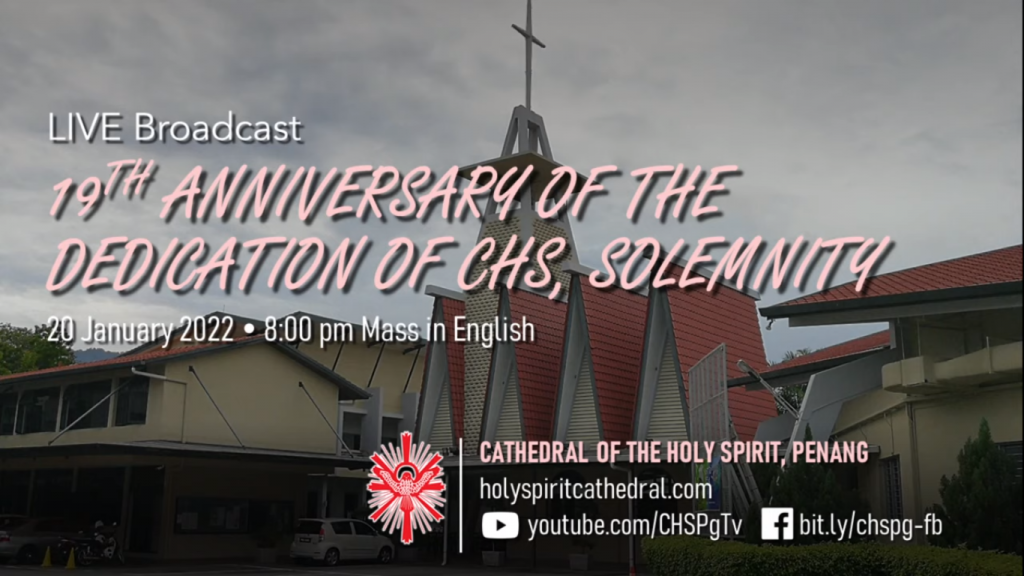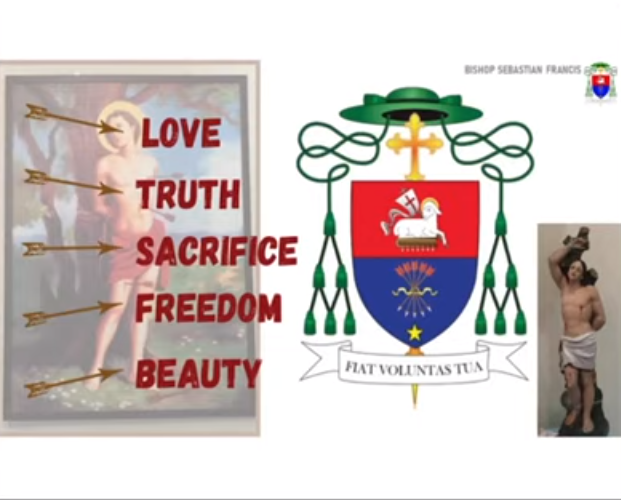by Rt Rev Bishop Sebastian Francis
2 Chronicles 5:6-11, 13-62
Psalm 83
1 Chronicles 3:9-11, 16-17
John 4:19-24
Theme: We are God’s Holy Temple

To appreciate the word of God today, so beautifully chosen by the Church to help us celebrate the dedication of this Cathedral, I want to take you to 1,500 years before Christ, to Moses.
The First Reading taken from the second book of Chronicles, which was the last book of the Hebrew bible and was written about 500 years before Christ, is talking about an event that happened before Mount Sinai where our dear father Moses was given the two tablets, the two tablets that contained the Ten Commandments. And he placed those two tablets in what is called the Ark of the Covenant and later on it became the central piece of the Temple in Jerusalem.
So that was the focus of worship of the Jews, of the Israelites, of the people of God. It as all about the Ark of the Covenant, the two tablets of Moses where God gave humankind through the Israelites, the Ten Commandments. And you and I know the consequences of nations and families and communities and individuals not obeying the Ten Commandments. It gets us into a spiral of violence and sin, committed to ourselves and to others. So that was the focus of worship, the Ark of the Covenant, the Temple of Jerusalem. And you saw how they worshipped God.
Then the Responsorial Psalm continues with the theme of worship and speaks about two human dispositions, longing and yearning. People who worship, they are longing and yearning for God.
Now get ready for a big revolution that is going to take place. And it began with Jesus and he is in Samaria. And he is talking to just one woman, the Samaritan woman at the well. And there he reveals something shattering about worship, about religion and he said that two thousand years ago.
You know, they were arguing about ‘Do we worship in Mount Gerizim in Samaria?’
Where is Mount Gerizim in Samaria where the Samaritan woman worshipped? It is in the West Bank City of Nablus today. Or ‘Do we worship in Jerusalem?’
There was competition, even in worship.
So Jesus makes this almost mind-boggling statement. He said, “My dear woman (and he is talking to each one of us), the hour will come. In fact it has come already when true worshippers will worship God, not in this mountain or that mountain, not in Samaria or Jerusalem but will worship the Father in spirit and in truth.”
And this is the kind of worshipper the Father wants. And those who worship must worship in spirit and in truth. Now this shattering, for all religions who are competing with one another.
Saint Paul who came after Jesus puts it in a very simple way. Imagine from this concept of the Ark of the Covenant, the Temple of Jerusalem (you know the Temple was destroyed about 30 years after Jesus and has never been rebuilt till this very day), Saint Paul who came after Jesus, he says ‘Now after Jesus, not before him, now you are God’s building.’
Oh my God! How do you make that transition from Jerusalem, Samaria, the Temple, the Vatican, Saint Peter’s Basilica, the Cathedral? How do you make the transition?
And now Saint Paul says “You are God’s building. You are God’s Temple and the Spirit of God is living among you.”
Now this is a massive change. And anyone who worships God can only worship God in spirit and in truth, whether in Samaria, or in Jerusalem, or in Saint Peter’s Basilica in Rome or in the Cathedral of the Holy Spirit or in any places of worship, for that matter. What does it mean to worship God in spirit and in truth?
And I cannot help but feel how these words have come true in the last two to three years, where almost every house of worship has been closed down. And it is difficult to get back to places of worship built by human hands in honour of God. But, wherever you are, you can continue and you must continue to worship God in spirit and in truth.
So that is the beautiful readings that we are given to reflect on the dedication of our Cathedral of the Holy Spirit.
Now I want to shift a little bit.
The Cathedral is all about the Bishop. No Bishop, no cathedral, in any where in the world. The word ‘kathedra’ in Greek simply means this blessed chair. That is it. This chair is the kathedra and there is only one guy who can sit on it in the Diocese and that is the Bishop. So this kathedra, this chair, is the symbol of unity and continuity in the Diocese.
Do you know this chair was not the original chair that was here? I discovered this chair (just a side story but to get back to the point) in the garage in College General and I asked the Rector about this chair. He told me this is the original chair of Bishop Francis Chan that was at the Cathedral of the Assumption. Somehow it did not end up here. And this is the chair in which my predecessors sat, the very same chair. So we restored it and brought it back here where Bishop Francis Chan, Bishop Gregory Yong, Soter Fernandez, Anthony Selvanayagam and myself am sitting on the chair, the kathedra, the symbol of unity and continuity.
So it is with the great sense of gratitude that I remember, and I ask you to remember our Bishops who served us, from Francis Chan to Gregory Yong to Soter Fernandez to Anthony Selvanayagam and myself and whoever will come after me. It is a story of continuity. It is not about personalities. It is about continuity.

So that is my code of arms, you will see it here in my vestment. Well, that is the code of arms. Every Bishop has a code of arms. And by,, in God’s plan, it so happened that the fifth Bishop of Penang, myself, so happens that the Feast of my patron saint, Saint Sebastian and the dedication of the Cathedral of the Holy Spirit falls on the same day.
So you will see five arrows in my code of arms, five arrows. The inspiration comes from Saint Sebastian who was martyred, or an attempt was made to kill him because of his fidelity to Christ during the Roman persecution. And those five arrows in my code of arms, it only will last as long as I am Bishop. Every Bishop has their own code of arms. The five arrows stands for:-
- the primacy of love,
– the primacy of truth,
– the primacy of sacrifice,
– the primacy of freedom, and
– the primacy of beauty.
These are the five arrows inspired by my patron saint, Sebastian, whose Feast is today, and in God’s design, the 19th Anniversary of the Dedication of the Cathedral of the Holy Spirit.
So these are the five guiding principles, as long as I am the Bishop, that guides me first and helps me govern the Diocese, through the primacy of love and truth, the primacy of sacrifice, freedom and beauty.
If sacrifice, love and truth is not free, then it is just nonsense. It must be free, whether from me or from the people of God of Kelantan, Perak, Kedah Perlis and Penang. And the motto below the five arrows is ‘Fiat Voluntas Tua’, ‘Let God’s will be done’.
In this Diocese, let love, truth, sacrifice, freedom and beauty bloom in this Diocese.
Amen.
Click below to listen to homily and watch video:-
Click to live-stream Mass on 20 January 2022